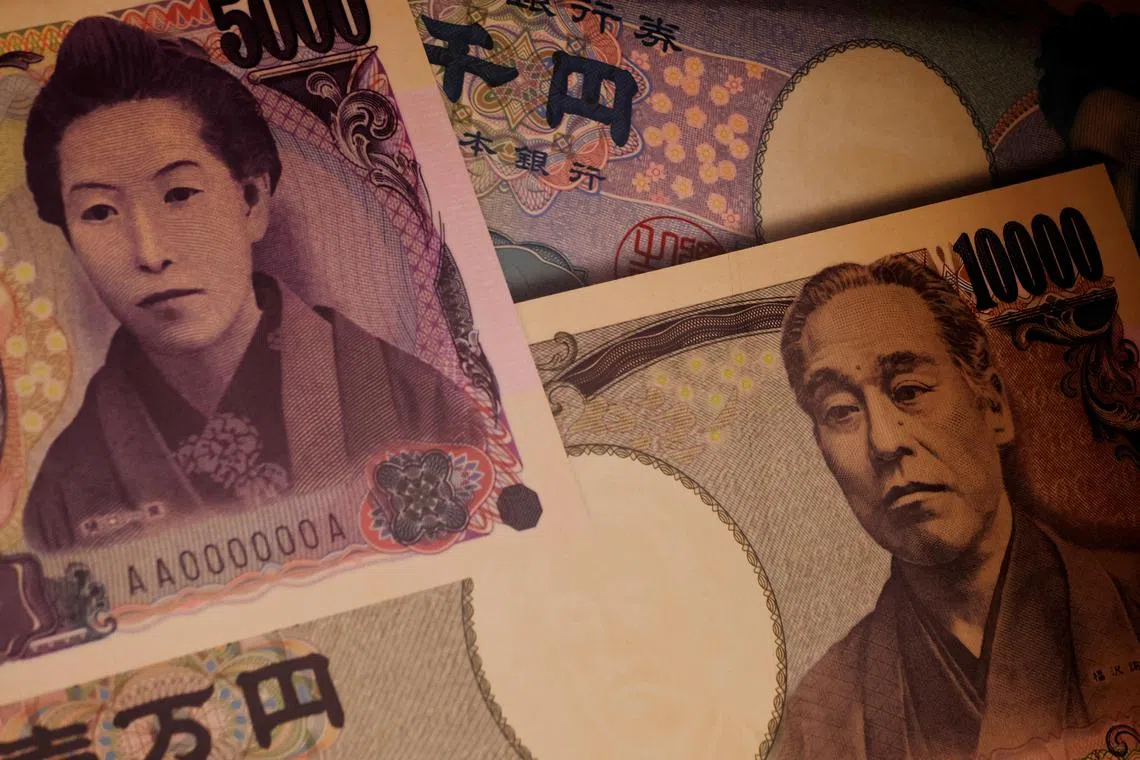Yen soars to 4-month peak, global markets jolted after surprise Bank of Japan policy tweak
Sign up now: Get ST's newsletters delivered to your inbox

The fallout from the move by Japan's central bank touched everything from US stock-index futures to the Australian dollar and gold.
PHOTO: REUTERS
Follow topic:
TOKYO - The yen surged to a four-month peak against the US dollar on Tuesday after the Bank of Japan (BOJ) stunned markets by deciding to review its yield curve control policy and widen the trading band for the 10-year government bond yield.
The fallout also touched everything from US stock-index futures to the Australian dollar and gold.
While it kept broad policy settings unchanged – pinning short-term Japanese government bond (JGB) yields at minus 0.1 per cent and the 10-year yield around zero – the BOJ decided to let long-term yields move 50 basis points either side of its 0 per cent target,
The market turbulence is unlikely to end on Tuesday. Japan is the world’s largest creditor, and tightening domestic financial conditions may result in a wave of capital returning home. That threatens to push down asset prices and boost global borrowing costs at a time the economic outlook is deteriorating. Investors are expected to exit bonds in the United States, Australia and France, and developed-market equities are also likely to decline, according to UBS Group AG.
“This was bound to happen with inflation rising in Japan, it’s just happened sooner than many thought,” said Mr Amir Anvarzadeh, an analyst at Asymmetric Advisors in Singapore, who has tracked Japanese markets for three decades.
“It could spark money flowing back into Japan. It will force Japanese investors to raise the hedging on their dollar exposure, which in turn strengthens the yen and becomes a self-fulfilling prophecy of more yen strength.”
At the post-announcement media briefing, BOJ governor Haruhiko Kuroda emphasised that the change was “not an interest rate hike”, but to improve bond market function. He reiterated that it is too early to discuss an exit from stimulus.
The dollar last traded 2.93 per cent weaker at 132.91 yen, after earlier tumbling as much as 3.1 per cent to 132.68 yen, a level last seen in mid-August.
Most BOJ watchers had expected no changes until Mr Kuroda’s 10-year term finishes at the end of March.
“This was really out of the box,” said Mr Bart Wakabayashi, branch manager at State Street in Tokyo.
“We’re seeing them start to test the market about the exit strategy,” he added. For dollar-yen, “we could see a break below 130. It’s very much within reach this year”.
The 10-year JGB yield jumped to 0.46 per cent from the previous cap at 0.25 per cent. It pulled equivalent US Treasury yields higher as well, with the 10-year soaring to the highest this month at 3.711 per cent.
The US dollar index sank, dropping 0.35 per cent to 104.25 and returning to the middle of its trading range this month of 103.44 to 105.90. The index measures the greenback against the yen and five other major peers, including the euro and sterling.
The index had been moving towards the top of that range before the BOJ announcement as investors continued to assess the Federal Reserve’s message of higher interest rates for longer.
The yen’s gains were broad, with the euro tumbling as much as 3.3 per cent to the lowest since late September at 140.44 yen and sterling at one point also sliding some 3.3 per cent to the lowest since Oct 12 at 160.76 yen.
Against the dollar, the euro was flat at US$1.0606 and sterling edged 0.07 per cent higher to US$1.2154.
The Aussie fell as much as 3.5 per cent to 88.18 yen, a seven-month trough, and New Zealand’s kiwi dipped 3.8 per cent to 83.82 yen, a two-month low, respectively.
“You can look across any yen pair and they look very similar – strength to the yen to the detriment to the currency you trade it against,” Mr Matt Simpson, market analyst at City Index, wrote in an e-mail. “From here it looks as though USD/JPY could be headed for 130 now that it has broken to a new cycle low.”
Against the greenback, New Zealand’s dollar dropped as much as 1 per cent to 63.01 US cents, a two-week low, extending earlier declines following a big drop in a survey of local business confidence. The Australia dollar slumped as much as 1 per cent to 66.29 US cents for the first time since Nov 22.
As for equities, the Nikkei 225 Stock Average slumped as much as 3 per cent, while futures of the S&P 500 Index dropped 0.7 per cent. REUTERS, BLOOMBERG

